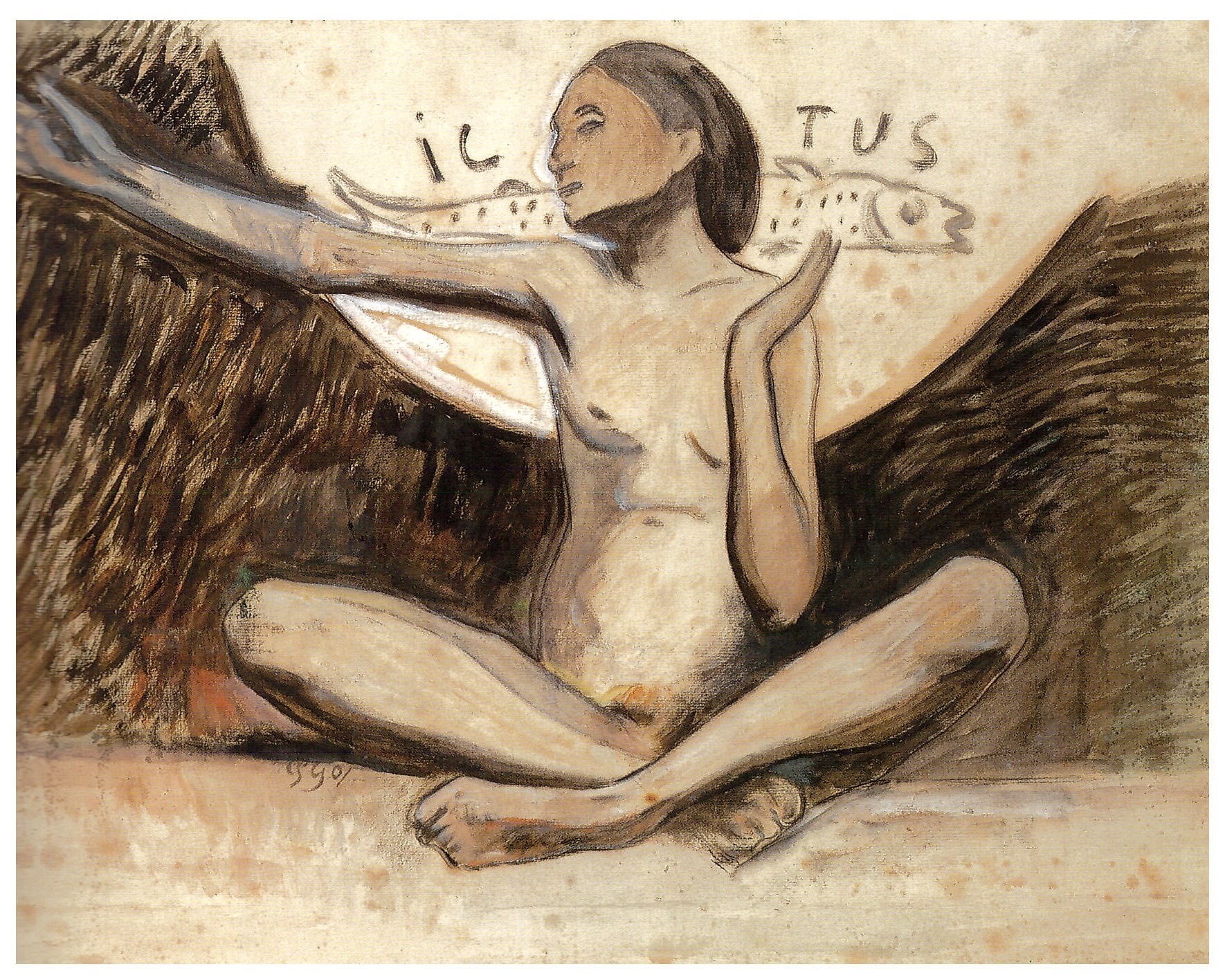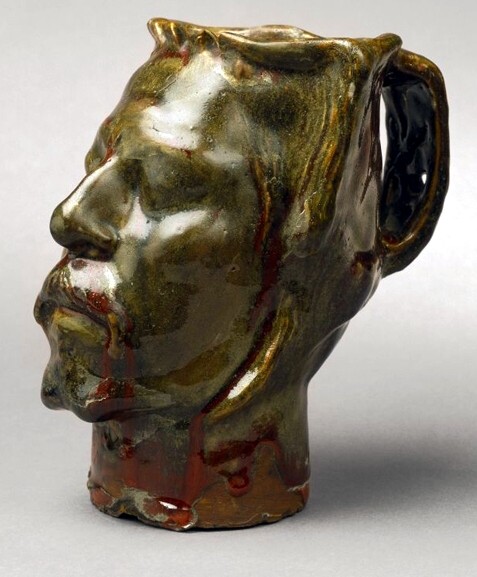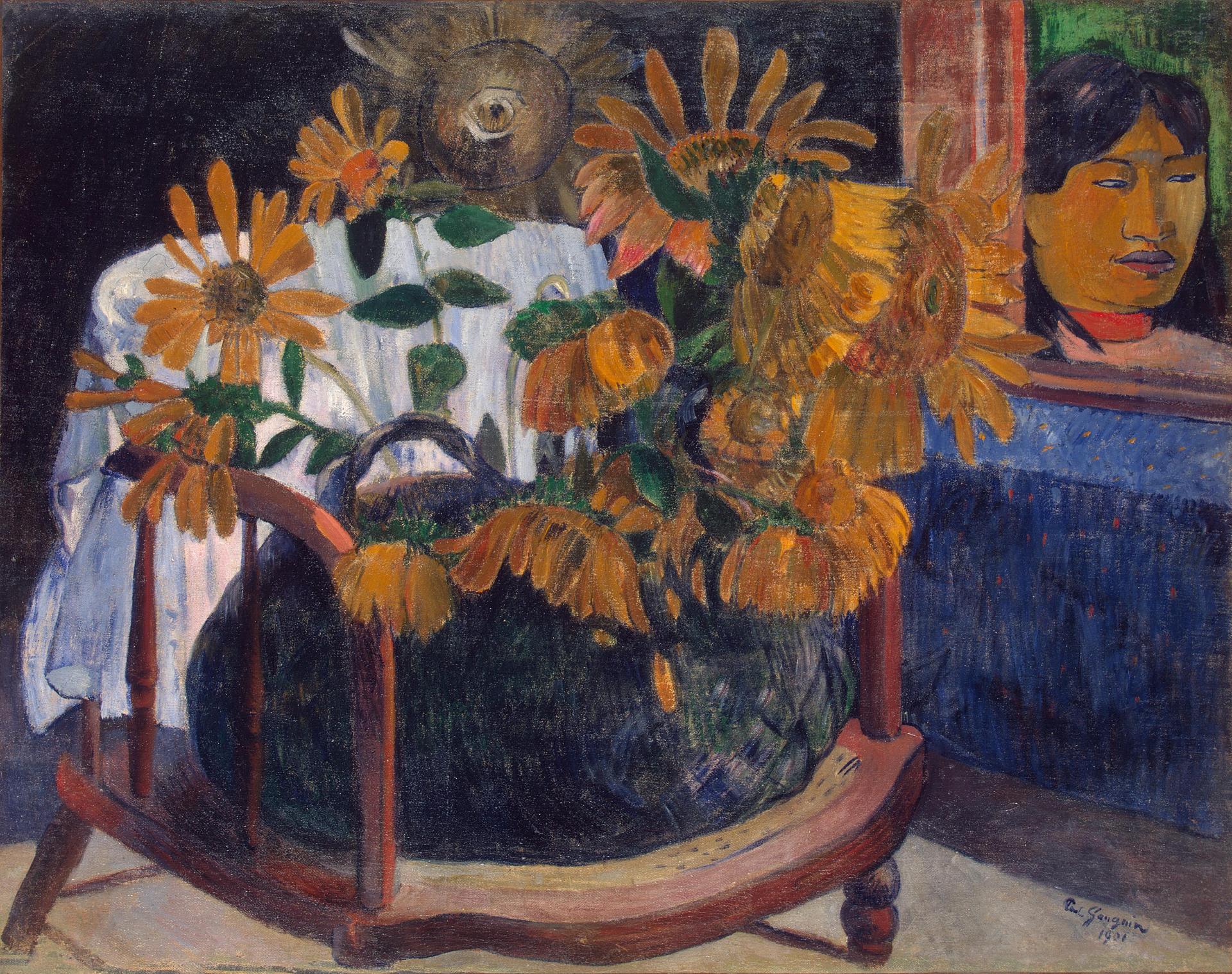V. Gibt es Hinweise in Gauguins Kunstwerken?
Ja, es gibt zahlreiche bildliche Hinweise auf Gauguins Verwicklung in das Ohr-Drama. Da er ein führendes Mitglied der symbolistischen Bewegung war, ist dies auch nicht sehr überraschend. Abgesehen von seinen Karikaturen des Commissaire Central Joseph d’Ornano (siehe oben) kommt Gauguins Verwicklung auch in mehreren seltsamen Kunstwerken zum Ausdruck, die er in Paris während der ersten Wochen nach seiner Flucht aus Arles geschaffen hat:
Erstens, das Bild „ICTUS“, eine Mischtechnik, die eine androgyne Figur darstellt, die ihr linkes Ohr durch eine Geste ihrer Hand dem Betrachter darbietet [ill. 2]11. Die gestische Präsentation des linken Ohrs in Verbindung mit der Darstellung eines Fisches mit der Aufschrift „ICTUS“ hinter dem Kopf der jungen Person sind deutliche Anspielungen auf den Ohr-Vorfall mit van Gogh: Der Fisch symbolisiert Verschwiegenheit, und in der Fechtersprache bedeutet „Ictus“ einen Hieb, Schlag oder Treffer (siehe unten, sowie Frage 11).

Illustration 2
Zweitens zeigt eine skurrile Tonvase in Form eines Selbstporträts mit dem Daumen am Mund12 einen erschrockenen und verängstigten Gauguin, der schweigen muss [ill. 3].

Illustration 3
Drittens verweist ein Keramik-Henkelkrug in Form eines Selbstporträts mit geschlossenen Augen, abgetrennten Ohren und am Gesicht herunterlaufender blutroter Glasur [ill. 4]13 direkt auf die kürzlichen Ereignisse um van Goghs Ohr: In psychologischer Umkehrung versetzt sich Gauguin hier an die Stelle van Goghs und vertauscht somit Täter und Opfer.

Illustration 4
Diese und andere Arbeiten Gauguins nach 1889, einschließlich seiner vier Sonnenblumenbilder mit dem „Auge“, die er 1901 auf Tahiti gemalt hat [ill. 5]14, werden im Lichte seiner Verwicklung in das Ohr-Drama neu zu interpretieren sein.
... mehr lesen
Illustration 5, link to source
---
Ictus
Ein weiterer Hinweis ist die wiederholte Erwähnung des Wortes „Ictus“ in Gauguins Skizzen und im bereits oben erwähnten Bild [ill.2]. „Ictus“ hat verschiedene Bedeutungen. Das griechische Anakrostichon ICTUS ist die Abkürzung für „Jesus Christus, Gottes Sohn, Erlöser“, und das griechische Wort „ichthys“ bedeutet „Fisch“. Die frühen Christen im alten Rom verwendeten den Umriss eines Fisches als Erkennungszeichen, als geheimes Symbol ihrer Gemeinschaft und als Warnung, „stumm wie ein Fisch“ zu bleiben.
„Ictus“ hat auch eine medizinische Bedeutung und bezeichnet einen plötzlichen Krankheitsausbruch, z.B. einen Schlaganfall, einen Infarkt oder einen epileptischen Anfall. Und schließlich bedeutet das lateinische Wort „ictus“ „Hieb“, „Stoß“, „Schlag“, „Wurf“ und wurde in Fechterkreisen auch gebraucht, um einen Treffer anzuzeigen.
Am Ende eines Briefes von van Gogh vom 21. Januar 1889 fügte Gauguin den Umriss eines Fisches mit der Inschrift „ICTUS“ hinzu, u.z. an der Stelle, wo Vincent schrieb „bevor ich krank wurde“(„avant de tomber malade“).15 Damit verwies Gauguin auf ein Geheimnis, das hinter dieser „Krankheit“ steckte.
Auf Seite 220 seines Skizzenbuches aus Arles notierte Gauguin einige Stichwörter, die sich auf seine Gespräche mit Vincent bezogen, unter anderem „Saul, Paul, Ictus“, wohl in Zusammenhang mit den religiösen Diskussionen zwischen den beiden.
Doch auf Seite 221 des Skizzenbuchs finden wir sehr auffällig das Wort „ictus“, umrahmt nicht von einem Fisch, sondern von einem Oval, das wie der Umriss einer abgeschnittenen menschlichen Ohrmuschel aussieht [ill. 6].

Illustration 6, Gauguin, sketchbook, p. 221
Dies ist ein eindeutiger Hinweis auf das Ohr-Drama und auf den „Hieb“ (ictus), der van Goghs Ohr abtrennte. Mehr noch: Oberhalb dieser Skizze finden sich einige Kritzeleien, eine verschlungene „8“ und zwei Zickzacks, die jeweils rechts mit einem Abwärts-Strich enden. Diese Kritzeleien oberhalb des Ohrs mit der Inschrift „ictus“ sind nicht zufällig oder ohne Bedeutung, da sich nirgendwo im Skizzenbuch Ähnliches finden lässt. Vielmehr sind sie zu deuten als Darstellung spezieller Fechtbewegungen: Gauguin rekonstruiert hier in Gedanken die Fechtbewegungen, mit denen er Vincents Ohr abgetrennt hatte („ictus“!).
11. Paul Gauguin, "Ictus" (1889); Watercolour and oil on paper; Collection Daniel Malingue: see Merlhès 1989, p.195; Druick/ Zegers 2001, p.279; Kaufmann/Wildegans 2008, p. 326-327. ↩
12. Paul Gauguin,, Glazed ceramic mug in form of a self-portrait, spring 1889 [B 53, G 66], Musée d'Orsay; see also Gösta Svenaeus: "Gauguin and van Gogh", in "Vincent" – Bulletin of the Rijksmuseum Vincent van Gogh, Vol 4 (1976), p. 22.; and: Druick/ Zegers 2001, p. 281.↩
13. Paul Gauguin, Glazed ceramic cup with handle in form of a self-portrait, ca. 1 Feb.1889 [B 48, G 65]; see Svenaeus ib., p.25, Druick/ Zegers 2001, p. 267, Kaufmann/Wildegans 2008, p. 333-334.↩
14. Gauguin, Sunflowers on an armchair, 1901 [W 603], see also [W 604], [W 605], and [W 606]↩
15. VvG to Paul Gauguin, 21 January 1889; Letters no. 739, see there also annotation [3] in vol.4, p.394↩